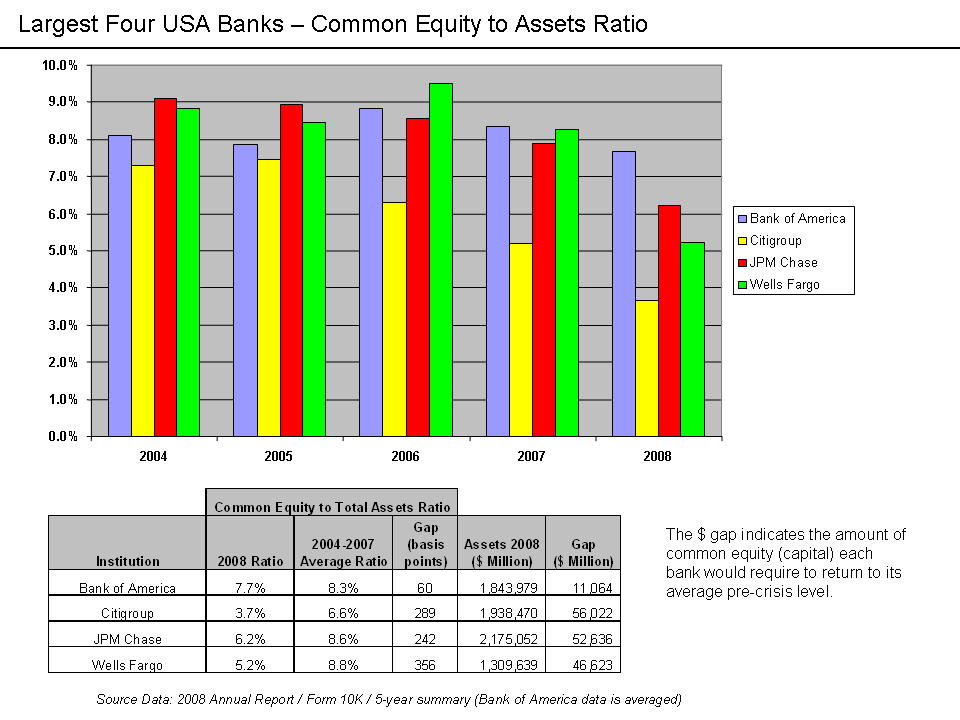Leverage 101 – The Real Cause of the Financial Crisis
Post on: 11 Июль, 2015 No Comment

Much of the current financial market crisis is blamed on two main factors – poor risk management by company executives and the ultra-depressed housing market. Company management is paying the penalty with most failed CEOs fired and years of lawsuits and regulatory probes ahead for implicated senior executives. The second factor, a depressed housing market, in itself is not new. Housing is cyclical and every 10 years or so we have a downturn flowered by a boom. Despite this being a much more severe downturn, you also have to remember prices almost doubled (boomed) before the collapse. What really caused the magnitude of the current financial crisis, in my opinion, was the amount leverage used in the housing market and mortgage backed securities derived from it. Leverage is a double-edged sword that is a powerful ally during boom times, but can quickly become your worst enemy during the ensuing bust. The collapse or bailout of some of our most highly regarded financial institutions – Fannie Mae. AIG. Lehman Brothers and Merrill Lynch was squarely due to leverage. What is leverage and how does it work? Below is a simplified example using three scenarios:
1. (No leverage) Assume I purchase outright (in cash) a home valued at $100,000. If that house increases in value by $10,000 in one year, my rate of return (appreciation) against my $100,000 cash outlay (down payment) is 10% ($10,000/$100,000). Not bad.
2. (Partial Leverage) Now assume that I purchase a home valued at $100,000 and only contribute $10,000 as a down payment and finance the remaining $90,000 at 6% (equivalent to $5,400 in annual interest). If the house increases in value by $10,000 in one year, my rate of return (appreciation) on my outlay (down payment plus the interest costs) is $10,000 / ($10,000 + $5,400) = 65%. So, through leverage of about 10 to 1, I was able to increase my rate of return significantly compared to scenario one where I had no leveraged debt.
3. (Maximum Leverage) Now assume that I purchase the same home valued $100,000 and only put down $1,000 as a down payment and finance the remaining $99,000 at 6% ($5,940 annual interest). If the house increases in value by $10,000 in one year, my rate of return is (appreciation in value) divided by (the down payment and the interest costs), $10,000 / ($1,000 + $5,940) = 144%! So through leverage of about 100 to 1, I was able to increase my rate of return by triple digits. Picture doing this for several years and as long as value rise, I would accumulate tens of thousands of dollars on an investment of $1,000 + interest costs. See how this could be so enticing for investors.
Most investment banks were leveraged by a ratio of 30 to 1, and they were dealing with billions of dollars instead of thousands. Government sponsored mortgage giants Freddie and Fannie were using leverage closer to 100 to 1, because of their supposedly stricter lending standards and implicit government backing. As you know, when asset prices are rising, this system works like a dream. but lets look at what happens when asset prices (in this case – houses) move downward.
In scenario #1 above, if the price of the house decreases by $30,000, other than the paper loss, as long as you dont sell, there are no problems because you have no leveraged debt. In scenario #3 above – maximum leverage, if the price of the house decreases by $30,000, heres what potentially happens:
- Lets assume the bank that lent you the $99,000 decides that the collateral (the value of the house) is no longer sufficient to cover the loan. They may ask you to come up with the difference between the current value of the home ($70,000) and the outstanding debt ($99,000). In order to protect the banks interests, they will want you to come up with $29,000.
- Now you have two options. First, you can give the bank the $29,000. But you probably didnt have it in the first place, so this is probably not a realistic option. Secondly, you could refinance your mortgage with another bank. But this probably wont work because you already have $29,000 of negative equity. All banks are going to be reluctant to give you money without collateral.
- So you most likely lose the house to foreclosure. This is exactly what is happening to a number of homeowners today.

Now lets map this scenario from a homeowner with a single mortgage to an investment bank that invests in millions of mortgages. If the day you bought the house you had a net worth of $1,000 – the cash you put down on your house then lets say your personal stock was worth $1,000. After the foreclosure you lost your $1,000 investment and now you personal stock is worth $0.
An investment bank may put down $1,000,000 for $30,000,000 worth of mortgages. So lets say the investment banks stock is worth $1,000,000. As housing prices drop, the investment bank has the same problem as you, they cannot refinance because nobody will lend them more money, so they start losing their houses to foreclosure. As the houses go into foreclosure – one by one – the investment banks value (and thereby stock) drops. In the end, the investment bank has the same value stock as your personal stock value – zero. Unlike you, the investment banks go hat in hand for a Federal bailout because they failed to manage their downside risk from leveraged debt.
So, the lesson of this story is not that leverage is bad; it just has to be understood for both the upside AND downside impacts. If the individual or investment bank were leveraged 3 to 1, they would have enough equity in the house(s) to either refinance or more likely, the bank would not have called-in the loan in the first place. Remember if you are leveraged 3 to 1, you have put down 33%. Therefore, the house(s) would have to fall more than 33% to become an issue. Plus, even if the house(s) eventually fell a total of 40% at the market bottom, and the bank called-in the loan, you would only need to come up with $7,000 ($67,000 mortgage $60,000 in current value), which is much more manageable for an individual or an investment bank than the $39,000 that would be required if you were leveraged 100 to 1 and the house dropped in value by 40%.
Going forward, I hope our regulators take heed of this when the next blend of investment banks emerges and Fannie/Freddie become profitable again. Hopefully the amount of leverage and actual equity is much more carefully regulated and 30:1 or 100:1 leveraging ratios are banned. Similarly, future homeowners should take this leverage lesson to heart and only purchase homes where they can afford a 20% down payment and so dont get as badly exposed when home prices fall.
Thanks to Tony Parker for his contributions to this post. Picture courtesy macca














